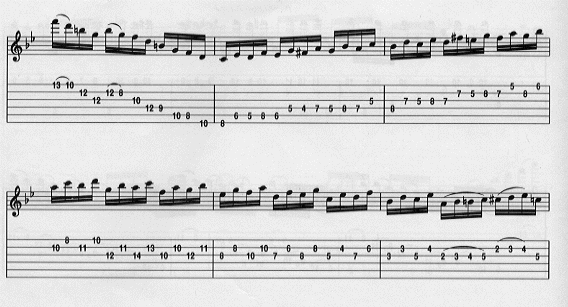Beginning in the early 1980s, Randy Rhoads was among the first guitarists who began to effectively bring classical influences into rock and metal. But it was in 1984, when Swedish-born guitarist Yngwie Malmsteen released his debut solo album "Rising Force", that the first distinct example of neoclassical rock guitar was introduced. Yngwie showcased guitar fretboard work to new heights. He also introduced a spectrum of new scales and modes to guitar students all over the world.
The following example is an excerpt from Niccolo Paganini's "24 Caprices".
Play this with alternate strokes, as directed, memorize small sections one at a time, and keep your hands relaxed. The first measure begins with a descending G major triad (G,B,D) on the first beat, followed by a descending G7 triad (G,B,D,F) on the second beat. The G7 arpeggio is actually functioning as the five of two chord (V of II) leading to an ascending C minor riff (the ii chord of Bb) in the second measure. The end of the second measure begins using ascending and descending Bb modal dyads. This analysis may sound a little heavy, but it is important info if you want to compose solos in this style.
Audio Example - MP3

John Tapella, guitarist, has authored over 20 note for note books for such artists as: Stevie Ray Vaughan, Eric Clapton, Yngwie Malmsteen, Rush, Bryan Adams and others.
Tapella also manages the Guitar Empiresite featuring a variety of instructional books and CDs.